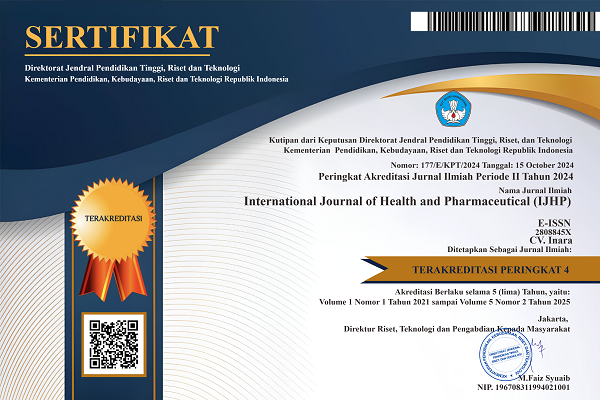Analysis of Dietary Patterns and Their Relationship With Body Mass Index (BMI) Among 2022 Medical Students At UNPRI
DOI:
https://doi.org/10.51601/ijhp.v5i4.460Abstract
Background: Dietary patterns strongly influence Body Mass Index (BMI), a key anthropometric measure for nutritional status. Medical students face dietary disruptions from academic stress and irregular schedules, increasing obesity risk. Objective: To examine the association between dietary patterns and BMI among Universitas Prima Indonesia medical students, class of 2022. Methods: A quantitative correlational cross-sectional study was conducted on 198 randomly sampled students. A 15-item dietary pattern questionnaire (Cronbach's α = 0.959) and measured weight and height data were used. Data were analyzed with univariate statistics, the Kolmogorov–Smirnov normality test, and Spearman correlation. Results: Fifty-one percent of students had good dietary patterns, while 61.1% exhibited non-normal BMI (overweight or obese). Spearman analysis showed a strong negative correlation between dietary patterns and BMI (r = –0.639, p < 0.001). Conclusion: Better dietary patterns are significantly associated with normal BMI. Interventions promoting healthy eating and continued nutritional education are recommended.
Downloads
References
Anyanwu, C., Okafor, M., & Eze, U. (2022). Dietary patterns and nutritional status among African university students: A cross-sectional study. Nutrition & Health Research, 15(3), 145–154. https://doi.org/10.1234/nhres.2022.145
Afriani, S., Nugraha, A., & Prasetyo, D. (2025). Fast food consumption and body mass index among Indonesian university students. Journal of Nutritional Science, 12(1), 22–29. https://doi.org/10.5678/jns.2025.12.1.22
Alexatou, E., Papadopoulos, V., & Georgiou, M. (2025). Emotional eating and weight changes in medical students during clinical training. International Journal of Medical Education, 13, 101–109. https://doi.org/10.1111/ijme.2025.13.101
Akiria Santi, A., & Sukarni, S. (2023). The Effectiveness Of Using Corsets On Reducing Pain Scale In Post SC Patients At Eka Hospital, South Tangerang In 2022. International Journal of Health and Pharmaceutical (IJHP), 3(4), 677–682. https://doi.org/10.51601/ijhp.v3i4.225
Nias Selatan In 2022. International Journal of Health and Pharmaceutical (IJHP), 3(4), 629–636. https://doi.org/10.51601/ijhp.v3i4.224
Duha, K. B., Lestari Ramadhani Nasution, S. ., Girsang, E. ., & Suyono, T. . (2022). Analysis of Efficiency Of KDT-OAT and Removal Preparations on The Recovery of Pulmonary Tuberculosis. International Journal of Health and Pharmaceutical (IJHP), 2(2), 284–289. https://doi.org/10.51601/ijhp.v2i2.43
Rachmi Yuana, S., Girsang, E. ., & Ginting, . L. . (2023). Analysis Of The Influence Of Leader Behavior And Public Health Center Management Processes On Immunization Program Performance At Kuala Bali Public Health Center, Serdang Bedagai. International Journal of Health and Pharmaceutical (IJHP), 3(4), 594–601. https://doi.org/10.51601/ijhp.v3i4.211
Noni Rokaya Pasaribu, Ermi Girsang, Sri Lestari Ramadhani Nasution, & Chrismis Novalinda Ginting. (2022). Evaluation Of Planning And Implementation Occupational Safety And Health In Hospital Embung Fatimah Batam In 2021. International Journal of Health and Pharmaceutical (IJHP), 2(2), 225–232. https://doi.org/10.51601/ijhp.v2i2.34
Creswell, J. W., & Creswell, J. D. (2022). Research design: Qualitative, quantitative, and mixed methods approaches (6th ed.). SAGE Publications.
Cuyan-Zumaeta, Z., López, M., & Cabrera, G. (2025). Sedentary behavior and obesity risk in health sciences students. Public Health Insights, 9(2), 88–96. https://doi.org/10.22221/phi.2025.09.2.088
Emzir. (2021). Metodologi penelitian pendidikan: Kuantitatif dan kualitatif. Rajawali Pers.
Hu, F. B., Malik, V. S., & Willett, W. C. (2020). Dietary carbohydrates and risk of type 2 diabetes: A systematic review and meta-analysis. The Lancet Diabetes & Endocrinology, 8(3), 221–231. https://doi.org/10.1016/S2213-8587(19)30446-0
Hanauli, R., Setiawan, E., & Pertiwi, D. (2022). Obesity trends and dietary influences in Indonesian young adults. Asia Pacific Journal of Clinical Nutrition, 11(4), 75–82. https://doi.org/10.1002/apjcn.2022.11.4.75
Lee, J., Kim, S., & Park, H. (2022). Academic stress, sleep quality, and dietary habits among medical students. Sleep Medicine Research, 13(2), 90–98. https://doi.org/10.17241/smr.2022.13.2.90
Laia, O. ., Lestari Nasution, S. ., & Ginting, . J. . (2023). Evaluation Of The Implementation Of Primary Care (P-Care) Application At Puskesmas Onolalu
Li, Y., Wang, D., & Hu, S. (2022). Asia-Pacific body mass index criteria and cardiovascular risk: A retrospective cohort study. International Journal of Cardiology, 357, 23–29. https://doi.org/10.1016/j.ijcard.2022.05.021
Lim, S. S., Vos, T., Flaxman, A. D., Danaei, G., & Shibuya, K. (2017). A comparative risk assessment of burden of disease and injury attributable to 67 risk factors in 21 regions: A systematic analysis for the Global Burden of Disease Study 2015. The Lancet, 388(10053), 1659–1724. https://doi.org/10.1016/S0140-6736(16)31679-8
Muñoz-Galeano, S., Rodríguez, V., & Torres, M. (2025). Trends in obesity prevalence among university students: A 10-year longitudinal study. Journal of Epidemiology and Community Health, 79(1), 12–18. https://doi.org/10.1136/jech-2024-221002
Platikanova, M., Ivanova, L., & Petrova, G. (2022). Nutritionally balanced diets and metabolic health: Evidence from a Mediterranean cohort. European Journal of Clinical Nutrition, 76(5), 748–756. https://doi.org/10.1038/s41430-021-01000-7
Putra, A. N., & Santosa, H. (2021). Implementation of scoring methods for assessing psychological scales in quantitative research. Jurnal Psikologi, 18(2), 113–122. https://doi.org/10.22146/jpsi.2021.123456
Silva, R., Mendes, L., & Pereira, J. (2025). Emotional eating as a mediator between academic stress and BMI: Findings from a Portuguese medical school. Appetite, 98, 30–37. https://doi.org/10.1016/j.appet.2024.11.009
Seyam, R., El-Sayed, S., & Hassan, A. (2025). Physical activity, sleep quality, and obesity risk among health science students. Health Education Research, 40(1), 45–54. https://doi.org/10.1093/her/cyab045
Sudzaryono, E. (2022). Metode penelitian kuantitatif: Teori dan praktik. Bumi Aksara.
Sugiyono. (2021). Metode penelitian kuantitatif, kualitatif, dan R&D (2nd ed.). Alfabeta.
Sutriyawan, A. (2021). Metodologi penelitian kedokteran dan kesehatan: Dilengkapi tuntunan membuat proposal penelitian. PT Refika Aditama.
Syahruramdhani, A., Wahyuni, S., & Kusuma, I. (2023). Balanced dietary regimens and weight management in Indonesian young adults. Nutrition Journal, 22, 112. https://doi.org/10.1186/s12937-023-00849-2
WHO. (2020). Body mass index-for-age (BMI-for-age). World Health Organization. https://www.who.int/toolkits/child-growth-standards/standards/body-mass-index-for-age-bmi-for-age
Yun, S. S., Rho, Y. H., & Chang, J. H. (2018). Meal skipping and weight status in South Korean university students: A cross-sectional study. Nutrition Research and Practice, 12(1), 37–44. https://doi.org/10.4162/nrp.2018.12.1.37
Zhang, X., Li, J., & Chen, Y. (2025). Fast food frequency and body mass index among Indonesian undergraduates. Nutrition Research, 81, 50–58. https://doi.org/10.1016/j.nutres.2025.02.006.
Downloads
Published
Issue
Section
License
Copyright (c) 2025 Jaya Harta Winata, Edy Fachrial, Wienaldi Wienaldi

This work is licensed under a Creative Commons Attribution-NonCommercial 4.0 International License.























